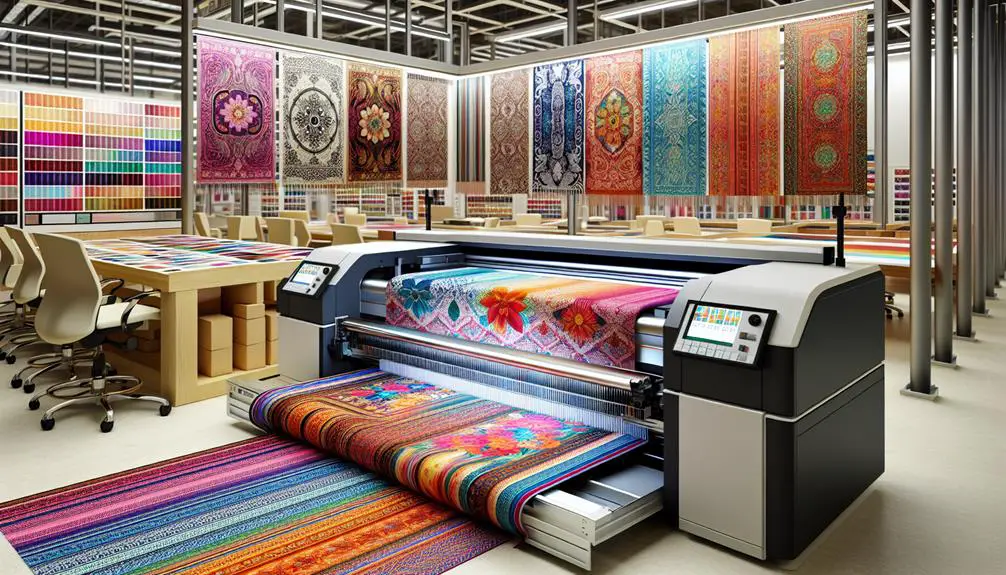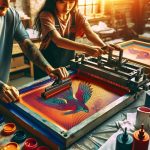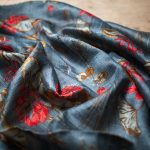You'll love how digital fabric printing is reshaping the textile world. Eco-friendly inks use natural ingredients and reduce harmful chemicals. You'll see faster, more efficient production with low waste and unlimited design options. Customize your prints on demand to fit any style. Smart textiles blend tech and fabric, offering interactive materials like fitness-tracking wearables. Advanced printing techniques, including direct-to-garment and sublimation dye methods, deliver vibrant, detailed, and long-lasting results. The market is growing with innovative, sustainable practices that appeal to eco-conscious consumers. Immerse yourself in these exciting trends and discover all the possibilities they bring.
Table of Contents
Key Takeaways
- Eco-friendly inks offer sustainability benefits with fewer chemicals and natural, biodegradable ingredients.
- Rapid setup and automated adjustments enhance speed and efficiency in digital fabric printing.
- Customizable designs allow for personalized patterns and on-demand changes, ensuring a smooth creative process.
- Smart textiles integrate technology and fabric, creating interactive materials with sensors and wearable tech.
- Advanced techniques like sublimation dye and 3D fabric printing produce vibrant, long-lasting, eco-friendly designs.
Eco-Friendly Inks
When it comes to digital fabric printing, using eco-friendly inks can make a huge difference for both the environment and your health. These inks are designed with sustainability benefits in mind. They contain fewer harmful chemicals and rely on natural ingredients. This means less pollution and a healthier planet.
Eco-friendly inks have a straightforward ink composition. Typically, they're water-based, which makes them less toxic. You'll find that they often contain biodegradable elements, reducing their environmental impact even further. Choosing these inks helps you contribute to a greener world.
Moreover, these inks provide excellent print quality. They offer vibrant colors and sharp details, ensuring your designs look professional. You won't need to compromise on the quality to be eco-conscious. In fact, many users find that eco-friendly inks perform just as well, if not better, than traditional inks.
Speed and Efficiency
Beyond selecting eco-friendly inks, you'll also appreciate the speed and efficiency of digital fabric printing. This method leverages production optimization and technology advancements to deliver rapid results. By streamlining workflows and incorporating printing automation, you can notably reduce production time.
Digital fabric printing eliminates many cumbersome steps found in traditional methods. There's no need for screen preparation or color separation, which accelerates the entire process. Plus, technology advancements ensure consistent quality across large batches, minimizing errors and waste.
| Traditional Printing | Digital Fabric Printing |
|---|---|
| Slow setup time | Quick setup time |
| Manual adjustments | Automated adjustments |
| High waste | Low waste |
| Limited designs | Unlimited designs |
By utilizing workflow streamlining, you'll find the process more efficient. Printing automation allows for continuous operation without constant supervision. This makes it easier to meet tight deadlines and handle large orders with ease.
Consider the impact on your business. Faster production times mean quicker turnaround for your clients. You can take on more projects and increase your output without compromising on quality. With these innovations, you're setting yourself up for success in a competitive market. Embrace the speed and efficiency of digital fabric printing and watch your productivity soar.
Customizable Designs
With digital fabric printing, you can easily create personalized patterns to fit your unique style.
It allows for on-demand design changes, so you can adapt quickly to trends or personal preferences.
This flexibility makes your creative process smoother and more efficient.
Personalized Pattern Flexibility
Imagine being able to create and wear a piece of clothing that's uniquely yours, reflecting your personal style perfectly. Digital fabric printing makes this possible through custom design and digital transformation. You're no longer limited to what's available in stores. Instead, you can design your own patterns and see them come to life on fabric.
This kind of personalized pattern flexibility offers an incredible range of options. Want a shirt with your favorite quote? You got it. How about a dress featuring a floral pattern you sketched yourself? No problem. Digital printing technology allows you to take your creative ideas and turn them into wearable art. It's like having your own fashion line, tailored specifically for you.
Moreover, the process is straightforward. You upload your design, choose your fabric, and the printing technology handles the rest. The colors are vibrant, and the patterns are precise. This isn't just for fashion designers; it's for anyone who wants to express themselves uniquely.
The digital transformation in fabric printing empowers you to move beyond standard designs. It's all about making your vision a reality, one print at a time.
On-Demand Design Adaptations
You can quickly adjust your designs to suit any occasion or preference with on-demand design adaptations. This flexibility guarantees that your creations meet specific needs and stand out. Design customization is at the heart of this trend, allowing you to modify patterns and colors effortlessly.
From a business standpoint, this leads to higher customer satisfaction as you cater to unique tastes.
Here's how on-demand design adaptations can benefit you:
- Rapid Prototyping: Quickly test new ideas and make changes on the fly. This creative freedom allows you to experiment without significant time or financial investment.
- Increased Customer Engagement: Clients love being involved in the design process. Letting them adjust designs boosts engagement and loyalty.
- Market Responsiveness: Adapt to trends and customer feedback instantly. Staying agile keeps your offerings fresh and relevant.
On-demand design adaptations empower you to be more responsive and innovative. Whether you're a seasoned designer or a newcomer, the ability to customize designs effortlessly will set you apart.
Embrace this trend to maximize creative freedom and guarantee customer satisfaction. This approach not only enriches your portfolio but also strengthens your market presence, making you a go-to expert in digital fabric printing.
Smart Textiles
Smart textiles blend technology and fabric to create innovative, interactive materials. These advancements are changing the way we think about clothing. Imagine wearing a shirt that can monitor your heart rate or a jacket that adjusts its temperature. This is wearable technology at its finest. Interactive clothing isn't just a concept; it's a reality that's gaining traction.
You might wonder how these smart textiles work. Sensors, conductive threads, and microcontrollers are integrated into the fabric. They collect data or perform specific actions based on environmental conditions. For example, fitness enthusiasts can benefit from garments that track their physical activity and provide real-time feedback.
This isn't just a gimmick; it's a step towards making your life more efficient and connected.
To master this field, you need to stay updated on the latest innovations. Companies are investing heavily in research and development to bring you the most advanced smart textiles. Collaboration between tech giants and fashion designers creates endless possibilities.
Whether you're a designer, engineer, or consumer, understanding smart textiles will give you a competitive edge. So, keep exploring and learning to stay ahead in this exciting industry.
Advanced Printing Techniques
Let's explore some advanced printing techniques that can transform your fabric designs.
You'll learn about Direct-to-Garment Printing, Sublimation Dye Techniques, and even 3D Fabric Printing.
These methods can elevate your projects to a whole new level.
Direct-to-Garment Printing
When looking for vibrant, detailed prints directly on fabric, Direct-to-Garment (DTG) printing stands out as an advanced and efficient technique. You'll love the way DTG printing handles intricate designs with ease. This method excels in ink durability and color vibrancy, ensuring your creations look stunning and last longer.
To understand why DTG printing is so effective, consider these points:
- Ink Durability: DTG uses water-based inks that bond well with fabric fibers. This results in prints that don't easily fade or crack, even after multiple washes.
- Color Vibrancy: The inks used in DTG printing are highly pigmented. They create rich, bright colors that stand out and capture attention, bringing your designs to life.
- Detail Precision: DTG printers can handle complex images with fine details. They print directly onto the fabric, achieving sharp lines and smooth gradients that other methods struggle with.
With DTG printing, you get high-quality results without the hassle. It's a fantastic choice for custom apparel, offering you both efficiency and excellence. Whether you're designing for fashion, promotion, or personal projects, DTG printing delivers superior prints every time.
Sublimation Dye Techniques
Among the advanced printing techniques, sublimation dye stands out for its ability to infuse vibrant colors directly into the fabric. You'll find this method delivers exceptional color saturation, making your designs pop with intensity.
Sublimation dye works by turning solid dye into gas without passing through a liquid phase. This gas then penetrates the fabric fibers, embedding the color deeply.
One of the biggest advantages you'll appreciate is the print durability. The colors don't just sit on the surface; they become part of the fabric itself. This means your designs won't fade, crack, or peel over time. Whether you're creating sportswear, fashion items, or home décor, sublimation dye ensures long-lasting quality.
Another benefit is the versatility. You can use this technique on a variety of polyester-based materials. It's perfect for producing intricate patterns and detailed graphics. Plus, the process is eco-friendly. No water is used, and there's minimal waste.
Mastering sublimation dye techniques will elevate your printing projects. You'll achieve professional results with rich, enduring colors.
3D Fabric Printing
D Fabric Printing offers cutting-edge techniques that will transform how you create custom textiles. You'll find these advanced methods not only elevate your designs but also contribute to sustainable fashion.
Let's immerse ourselves in three key innovations that are shaping the industry:
- High-Resolution Printing: Achieve intricate details and vibrant colors with precision. This allows you to bring your most complex designs to life, making every piece a work of art.
- Eco-Friendly Inks: Use water-based, non-toxic inks that reduce environmental impact. These inks are part of the digital innovation driving sustainable fashion forward, ensuring that your creations are as kind to the planet as they're stunning.
- On-Demand Production: Print only what you need, when you need it. This approach minimizes waste and allows for greater flexibility in your projects, keeping your inventory lean and your designs fresh.
Market Growth and Opportunities
The digital fabric printing market is booming with new technologies and expanding opportunities. You'll find that industry partnerships and emerging technologies are driving this growth. Companies are collaborating to bring innovative solutions to the market. This synergy is creating cutting-edge printing methods that are faster, more efficient, and more versatile.
Sustainable practices are also at the forefront. Brands are increasingly adopting eco-friendly methods to reduce waste and conserve resources. This shift isn't only good for the planet but also appeals to a growing segment of environmentally-conscious consumers. As a result, businesses can expect to see a rise in demand for sustainably produced fabrics.
Global expansion is another exciting prospect. Markets in Asia, Europe, and the Americas are rapidly adopting digital fabric printing. This widespread acceptance is opening up new avenues and customer bases for businesses. You can tap into these opportunities by staying updated on regional trends and preferences.
Frequently Asked Questions
How Does Digital Fabric Printing Impact Traditional Textile Manufacturing Jobs?
Imagine a storm shaking the trees. Digital fabric printing impacts traditional textile manufacturing by causing job displacement. Workers must shift and adapt to new roles, like learning advanced tech skills, to stay relevant in the industry.
What Are the Primary Maintenance Requirements for Digital Fabric Printing Machines?
To keep your digital fabric printing machines running smoothly, you'll need to focus on routine cleaning and regular calibration. Clean the print heads and other components often. Calibrate the machine to guarantee accurate and consistent prints.
How Does Digital Fabric Printing Compare in Cost to Traditional Screen Printing?
You'll be shocked! Digital fabric printing can save you a fortune compared to traditional screen printing. The cost comparison shows digital wins hands down, especially with its lightning-fast printing speed and minimal setup costs.
What Types of Fabrics Are Best Suited for Digital Fabric Printing?
You should choose fabrics like silk, polyester, and cotton for digital fabric printing. These materials offer excellent durability and print quality. Additionally, they align well with sustainability goals, making them perfect for eco-conscious projects.
Are There Any Limitations in Color Vibrancy With Digital Fabric Printing?
Yes, you'll notice some limitations in color vibrancy with digital fabric printing. However, advancements in technology have greatly improved color accuracy and print durability. You'll achieve vibrant results on high-quality fabrics using the right processes.
- How Does Ring Spun Cotton Affect Garment Fit and Shape Retention? - August 13, 2024
- What Are the Challenges in Producing Ring Spun Cotton? - August 13, 2024
- Is Ring Spun Cotton Suitable for Plus-Size Clothing? - August 13, 2024





